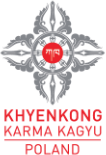
2nd Beru Khyentse Rinpoche is one of the most important lamas and lineage holders in the Karma Kagyu tradition of Tibetan Buddhism. Recognized by the 16th Karmapa Rangjung Rigpe Dorje in 1955 as the reincarnation and emanation of mind of Jamyang Khyentse Wangpo, he is one of the most important masters and visionaries in the history of Buddhism in Tibet. He was enthroned and became the head of the Nangchen monastery in Tibet. At the age of 13, sensing the impact of the Chinese Cultural Revolution, he led his monks and lay students the way to Mainpat mountain in India, where he founded a monastery and retreat centre.
Rinpoche underwent intensive studies in Buddhist philosophy and practiced advanced Vajrajana techniques, receiving instructions and empowerments from the greatest masters of meditation, including: His Holiness the 16th Gyalwa Karmapa, Dzongsar Khenpo Chimey Rinpoche, Kalu Rinpoche, Dilgo Kyentse Rinpoche, His Holiness Sakya Trizin and the 14th Dalai Lama.
The Rime Movement was initiated in the 19th century by the first incarnation of Beru Khyentse Rinpoche – Jamyang Khyentse Wangpo (1820-1892), an outstating master of Tibetan Buddhism, a scholar, yogi, and visionary, formally connected with the Sakja tradition, Chokgyur Lingpa (Nyingma) and Jamgon Kongtrul (Kagyu). The idea of the Rime Movement consisted in an unbiased respect for other schools of Buddhism. The initial goal was to preserve all the transmission lineages of Tibetan Buddhism for future generations (as some of them, e.g. the Shangpa Kagyu lineage, were vanishing at the time), to bring the practitioners of various traditions closer to each other as well as to disseminate the teachings of the Great Perfection (Dzogchen) and the Great Seal (Mahamudra) in an unprejudiced, non-sectarian manner. Jamyang Khyentse Wangpo was also one out of five Great Tertons, discoverers of the treasure teachings which Guru Rinpoche and his tantric partner Yeshe Tsogyal had hidden for the future generations. Those teachings could be discovered only be the highly realized masters, descendants of Guru Rinpoche’s disciples. Jamyang Khyentse Wangpo was considered to be the emanation of king Trisong Detsen – the one who had invited Guru Rinpoche to Tibet and became one of his closest disciples.
After the Great Khyentse had passed away, his numerous emanations were recognized in various schools of Buddhism, such as Dilgo Khyentse (emanation of the mind) in Nyingma tradition or Dzongsar Khyentse (emanation of the heart) in Sakja tradition. The emanation of his speech was Beru Khyentse (1896-1945), the son of King Gönpo Düdul of the Kham Province, Eastern Tibet. The tulku was recognized by Jamgon Kongtrul Lödro Thaje and enthroned at Palpung monastery of Karma Kagyu tradition. Upon completing his own education, he started to teach. His disciples derived from all the four traditions of Tibetan Buddhism. Within the Karma Kagyu, in which Beru Khyentse is one of the main lineage holders, among his disciples were such masters as: 15th Karmapa Khakyab Dorje (the Karmapa was at the same time Beru Khyentse’s guru), 16th Karmapa Rangjung Rigpe Dorje, Pawo Rinpoche, Kalu Rinpoche, Khandro Orgyen Tsomo (the 15th Karmapa’s wife).
In 1975, the 2nd Beru Khyentse completed the four-year retreat, and started to establish and reconstruct the monasteries in India and Nepal. On his initiative, monasteries in Bodhgaya and Kathmandu were founded and Sakya Monastery in Tibet was rebuilt. Rinpoche is the founder of the Tharjay Charitable Foundation, the organization that supports the building of bridges, schools and health centres in Eastern Tibet. He also actively supports the local community by providing aid to the deprived e.g. victims of the earthquake in Nepal.
Despite his many charitable activities, the 2nd Beru Khyentse Rinpoche continues to share the Dharma as a yogic meditation master and lineage holder. He travels around the world offering his teachings and empowerments. He is particularly known in South-east Asia and the Antipodes. The initiations he gave in Europe include the Kalachakra (Karma Guen, 2009), Gampopa (Benalmadena, 2009), Vajrayogini (Athens, 2010) and Manjushri (Budapest, 2011) empowerments. He visited Poland on four occasions, with the first visit taking place in 1984. In 2016 Beru Khyentse Rinpoche and Jamgon Kongtrul Rinpoche made a decision to establish the Khyenkong Karma Kagyu Buddhist Centre in Poland.
